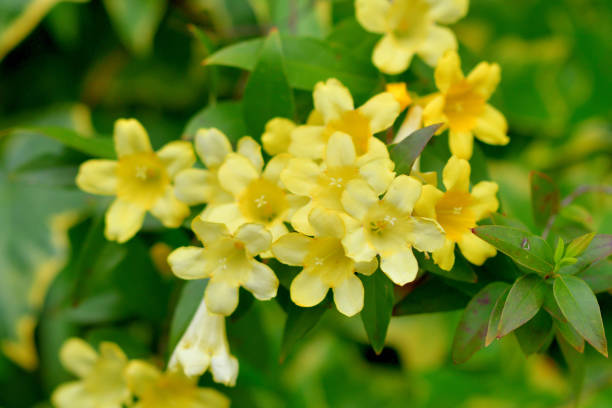Shimla: In a rare conservation initiative, a team of biodiversity enthusiasts comprising serving and retired forest officials, have found the rare yellow Jasmine flower, which is on the verge of extinction, in the remote forests of Bharmour in the Chamba district of Himachal Pradesh.
Bharmour, located at a height 8,500 feet in the high Pir Panjal mountain ranges, is a land blessed with pristine beauty of abundant alpine pastures and provides home for nomadic shepherds, known as Gaddis.
“Ours is not a first discovery, yet it is certainly an effort to underline the value of a flowering plant that was researched in 1890 in this region. It’s a plant which is critically endangered and only 100-odd plants are left” says G S Goraya, a former Principal Chief Conservator of Forests in Himachal Pradesh.
Goraya had recently led a team of forest officials including Divisional Forest Officer (Wildlife) Chamba Amit Sharma deep to the forest areas in Bharmour and found the plant surviving under local soil-climatic conditions suited to its growth.
“The sighting of the yellow Jasmine plant is seen as a landmark conservation effort in the high mountains known as a hot spot of rich biodiversity. This will help the researchers to take forward the effort to preserve the germplasm” says Deputy Commissioner Chamba Aproov Devgan.
The exploration team said that the yellow Jasmine plant was found in the forest adjacent to the Garima area.
Tracing its history, Amit Sharma said the species has a thin endemic presence and was first collected by J .H Lace, a British researcher from forests of Rupani, near Bharmour in 1899. Reports say the plant’s germplasm is also preserved in London for research and propagation.
After remaining inconspicuous for nearly 20 years, R N Parker collected the plant again in 1919 from the Holi area. The species again missed botanists’ attention for nearly 90 years till a team from IHBT (Institute of Himalayan Bioresource Technology), Palampur collected the plant in 2012. Only 24 plants spread over an area of two kilometres were located, mainly on the road side.
Later road widening works and other human activity posed an added threat to the existence of the plant since not many people were aware about its importance or the fact that it is facing extinction. Thus, the researchers feel that Himachal Pradesh Biodiversity board is required to take further steps for conservation of the plant
“On our side, we are committed to working in a systematic and organized manner to ensure the successful conservation of this species. Detailed strategies and measures will be devised to protect the habitat, propagate the plant, and raise awareness about its significance,” said DFO (wildlife) Chamba.
The yellow Jasmine, also known as dwarf Jasmine, Himalayan Jasmine, or Parker Jasmine, belongs to the Oleaceae family. Native to the western Himalayas, this dwarf variety typically grows to a height of one foot and spreads over a 2.5 square feet area.
Yellow Jasmine is a wonderful shrub with yellow trumpet-shaped blooms. The dynamic display of bright, yellow colour throughout the spring is considered to be absolutely amazing .
The plant usually thrives in a range of soil conditions but prefers well-drained areas. With compact compound pinnate leaves comprising three to five leaflets, this deciduous shrub adds a touch of elegance to its surroundings, Amit Sharma says.
The yellow Jasmine blooms in early summer. However, it is important to note that due to its susceptibility to colder climates, the yellow Jasmine is limited to zones 9 through 10, as it is not winter hardy in colder regions.
Goraya earlier had also led a team of forest officials to Kinnaur to discover a plant named ‘Carpinus faginea’ in Kinnaur –a high altitude tribal district.




















